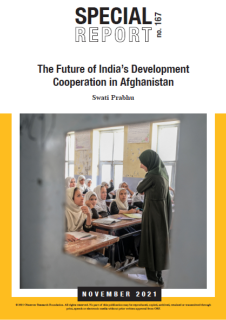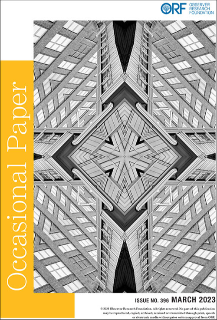
The classical explanation to transboundary water conflicts has hinged upon the Malthusian doctrine that relates such conflicts to increasing physical scarcity of water over time. There is no denying that per capita water availability across the globe has been declining due to spurt in population growth over the last five decades. Water demand is also getting diversified with emergence of newer consumption forces driven by rapid urbanisation, greater food and energy needs, and extensive diversification of human water use. Given that transboundary water governance and global water diplomacy is still largely driven by the age-old classical Malthusian creed, I have three propositions in this essay:
• The notion of “transboundariness” of water needs to be changed in the global water governance thinking and needs to be much more inclusive.
• The Malthusian creed fails in providing an explanation to the newer challenges of transboundary water governance, and explanations need to be sought in newer variables contigent upon combining supply and all forms of demand forces. Scarcity Value of water is one such variable.
• Of various demand and supply-side interventions, virtual water imports is a critical instrument addressing scarcity value of water, and helping an explanation and resolution of transboundary water conflicts.
Transboundary waters redefined
At the very outset, let me come to the definition of transboundary waters. The body of literature emerging from International Relations, Strategic and Geopolitical Studies defines transboundary waters in the form of a “fugitive” resource that crosses international geographical boundaries. Even today, geographers, strategic studies experts, and those working in the domain of hydropolitics delineate “transboundariness” of waters in such terms (e.g. Mirumachi 2015; Islam and Susskind 2018). Such positions are endorsed by the United Nations as well. However, a review on transboundary water disputes published in a book published in 2000 by Beach and his co-authors took into its purview a more expanded definition of transboundary waters by including waters crossing any form of boundary and at all levels (from the international level to the most micro-level of an economy) including sectoral boundaries. The connotation of including sectoral boundaries is that intersectoral water allocations or conflicts are issues of transboundary water governance. On more recent counts, the “transboundariness” of water has become even more pronounced with the emergence of conflicts over its use across two major systems: the economic system, and the natural ecosystem. That such conflicts are already acknowledged in policy academic domains can be evidenced from the steady emergence of the literature on Integrated Water Resource Management (IWRM) that talks of an integrated approach to manage water by including the ecosystem functions and services along with addressing human economic needs in the fold of water governance. At a basin scale, this is known as Integrated River Basin Management (or Governance at times, IRBG in short). This is also reverberated in the call for systems approach to water systems, redefined as WEBS (Water, Energy, Biodiversity, and Sediments) approach. Therefore, water governance at all forms is addressing the various issues and concerns at transboundary levels only. This expanded definition of “transboundary waters” is in conformity with the delineation of environmental flows that delineate the flow regime of a water system meeting the various environmental and human (social, economic, cultural, etc) needs through a negotiated approach. Such an integrated approach through a more holistic definition of “transboundary” waters is the hallmark of the new paradigm of water governance.
The connotation of including sectoral boundaries is that intersectoral water allocations or conflicts are issues of transboundary water governance.
The failure of the Malthusian creed: Water’s scarcity value
From the above definition of transboundary waters, I now approach the very Malthusian creed of scarcity-driven-conflicts over transboundary waters. The most popular index of physical availability of water, developed in the late 80s by Malin Falkenmark and her colleagues, became popular as the Falkenmark Water Barrier Scale. Despite being a popular tool to express the state of water in nations or river basins, this indicator was largely a supply-side one, and could hardly reflect on the demand side. Similar was the case with most of the indices developed in the 1990s. In a literature survey, I found that interesting indices that were developed over time included the Water Poverty Index, or even classifications of scarcity and appropriations. Lately, in India, NITI Aayog has also developed an index, which is largely based on demand management and can hardly accommodate supply-side parameters. In fact, most indices that have been developed have either addressed demand side conditions or supply-side conditions rather than be integrating them, and could not be taken as a universal explanatory variable for water conflicts.
This is where the scarcity value of water becomes important. I developed this theory in a previous paper in 2009 published in the journal Water Policy, and interpreted scarcity value of water in a water-scarce economy as the value that could have been generated if the ceiling on water availability is relaxed by a unit. This value is contingent upon the most valuable water use in an economy or a sector. Since the water is scarce and the ceiling on its availability is binding, the value is not created. Therefore, scarcity value (interpreted as the value of scarcity) measures the degree of deprivation of an economy in a river basin, and can be expressed both at the scale of a basin and an economy. So, in the case of upstream-downstream water conflicts, a higher scarcity value of water for upstream will urge it to divert more water thereby increasing the scarcity value of downstream. If water is put to valuable use, higher is the loss per unit of water, and higher is the scarcity value, which further leads to greater conflict intensity. In the case of Cauvery water conflicts in India, the basin witnessed manifold rise in agricultural area for paddy in the 1990s, as compared to the 1980s, due to the price signals and increasing availability of water due to infrastructure development. I estimated that the scarcity value of water in the summer paddy of Karnataka was non-diminishing despite manifold increase in water use, and so was the case with the Kuruvai paddy in Tamil Nadu. With the former’s growing and harvesting periods coinciding with latter’s sowing and growing periods, there was a temporal coincidence of demand for water in a scenario of high scarcity values. This has made high intensity conflicts an annual event!
In the case of upstream-downstream water conflicts, a higher scarcity value of water for upstream will urge it to divert more water thereby increasing the scarcity value of downstream.
The utility of scarcity value does not end here. The MENA region is inflicted with high water scarcity. As per various water scarcity indicators, the conditions of the rivers of MENA (Nile, Euphrates, Tigris, Jordan-Yarmuk, etc) are worse than most river basins across the world. Yet, post the middle 1990s, water, which used to be a contentious subject between the riparians of the Jordan-Yarmuk, started emerging as a subject of regional cooperation. The physical condition of the resource is much worse than the contentious water-scarce basins of south Asia (e.g. Indus, Cauvery, or Narmada-Godavari). If one looks at the phenomenon deeply in the Jordan-Yarmuk system, one will find that nations like Israel essentially resorted to reducing scarcity value of water through extensive demand-management, rather than addressing scarcity through supply-augmentation plans that are infeasible in water-scarce regions, and are prone to lead to conflicts. However, conflicts in South Asian basins are largely results of addressing scarcity through supply-augmentation. The importance of scarcity values also lies in the fact that even the sectoral conflicts between ecosystem and economic needs can be understood through this. This was explained in one of the recent research over the upper Ganges canal where agricultural demand management through increases in water-use-efficiency and crop diversification in favour of less water-intensive crops led to an increase in values of downstream ecosystem services. My moot point in this essay is that the notion of “scarcity value” is embedded in the new emerging paradigm of IWRM. Therfore, the shift from the old paradigm to the new paradigm should be understood as the shift from addressing “scarcity” to understanding and addressing “scarcity value.”
Conflicts in South Asian basins are largely results of addressing scarcity through supply-augmentation.
Virtual water imports to diminish scarcity values
In this context, I bring in the notion of virtual water (VW) imports, Prof. Tony Allan’s magnum opus. VW is the volume of water needed to produce a commodity or service. Therefore, when a water-intensive crop (that, for example, has consumed 1,000 units of water in the production process) is imported in a water-scarce economy, the economy virtually brings in 1,000 units of water within its system. Hence, VW trade enables water scarce regions to meet their food needs through imports. Water scarcities over vast distances get ameliorated in the process. Water-scarce economies like Israel have attempted to balance their water budget (by bringing semblence between water demand and supply) by “virtually” bringing in water through commodity imports in their economies. In that sense, through VW imports, these economies reduced the scarcity value of water, not really addressing physical scarcity through supply-augmentation plans. On a different note, virtual water trade can even help environmental needs to support downstream ecosystem services, and has therefore been heralded as a critical water demand management option, which is the crux of the IWRM.
Conclusion
Transboundary water governance is a complex problem. The traditional thought processes of conflict resolution and governance are falling flat in the face of the newer water governance challenges. Therefore, a new set of thought processes and conceptual understanding are needed to address these challenges. That will entail the necessary paradigm shift that this essay intended to highlight by bringing in the three propositions.
The views expressed above belong to the author(s). ORF research and analyses now available on Telegram! Click here to access our curated content — blogs, longforms and interviews.




 PREV
PREV


